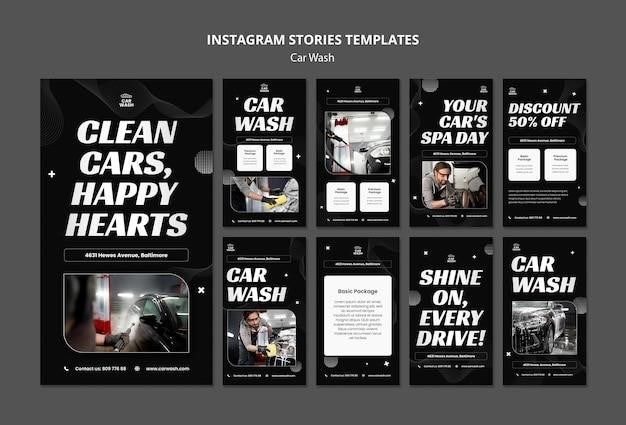Car Detailing Guide⁚ A Comprehensive Guide to Make Your Car Shine
This guide will help you learn how to detail your car like a pro. It covers everything from washing and waxing to polishing and conditioning, with tips, tools, and products for each step.
What is Car Detailing?
Car detailing is a comprehensive process that goes beyond a simple car wash. It involves a thorough cleaning, restoration, and protection of your vehicle’s interior and exterior. Detailing aims to remove dirt, stains, and impurities from every nook and cranny, restoring your car to its original condition or even exceeding its initial shine. It’s a meticulous process that involves various techniques and products to enhance the appearance, protect the paint, and preserve the overall value of your car.
Types of Car Detailing
Car detailing encompasses a range of services, each tailored to address specific needs. The most common types include exterior and interior detailing. Exterior detailing focuses on restoring the exterior paint, removing contaminants, and applying protective coatings. It involves steps like washing, clay bar treatment, polishing, and waxing. Interior detailing, on the other hand, involves cleaning and restoring the interior surfaces, including upholstery, carpets, dashboards, and door panels. This may include vacuuming, shampooing, leather conditioning, and odor removal.
Exterior Detailing
Exterior detailing involves a comprehensive approach to restoring and protecting the exterior of your vehicle. This process typically includes a thorough wash, using a specialized car wash soap and techniques to remove dirt, grime, and debris. Next, a clay bar treatment is applied to remove embedded contaminants, such as tree sap, overspray, and industrial fallout. After decontamination, the paint surface is polished to remove swirl marks, scratches, and oxidation, restoring a smooth and glossy finish. Finally, a protective layer of wax or sealant is applied to shield the paint from the elements and enhance its shine and durability.
Interior Detailing
Interior detailing focuses on transforming the inside of your car into a clean and inviting space. The process begins with a thorough vacuuming of all surfaces, including carpets, seats, and floor mats, removing dust, dirt, and debris. Next, the interior is cleaned using specialized cleaners to remove stains, spills, and greasy residue from surfaces like leather seats, dashboard, and door panels. For fabrics, upholstery cleaners are used to remove dirt and odors. Finally, interior detailing often involves applying protectants to leather seats, dashboard, and other surfaces to help maintain their condition and repel dirt and stains.
Importance of Car Detailing
Car detailing is more than just a cosmetic enhancement. It plays a crucial role in maintaining your car’s overall health and longevity. A detailed car is protected from the elements, preventing premature wear and tear on the paint, upholstery, and other components. Regular detailing helps preserve the car’s value, making it more appealing to potential buyers in the future. Moreover, a clean and detailed car creates a more enjoyable driving experience, enhancing the overall aesthetic appeal and promoting a sense of pride in ownership.
Comparison Between Car Detailing and Car Washing
While both car washing and detailing aim to clean your vehicle, they differ significantly in their depth and scope. Car washing primarily focuses on removing surface dirt and grime, often using soap and water. In contrast, car detailing goes beyond a basic wash, involving a meticulous cleaning and restoration of the vehicle’s interior and exterior. This includes removing contaminants, polishing the paint, protecting surfaces, and restoring the car’s original shine. Car detailing is a more comprehensive and thorough process, resulting in a significantly enhanced appearance and protection for your vehicle.
How Often Should I Opt for Car Detailing?
The frequency of car detailing depends on various factors, including your driving habits, environmental conditions, and desired level of maintenance. For optimal results, it’s recommended to detail your car at least twice a year. However, if you frequently drive in harsh weather or dusty environments, more frequent detailing may be necessary. Consider detailing your car after winter or during the summer to protect it from the elements; Ultimately, the decision boils down to your personal preference and the level of care you want to provide for your vehicle.
How Long Does It Take to Detail a Car?
The duration of a car detailing job varies depending on the extent of the detailing, the condition of the vehicle, and the level of expertise of the detailer. A basic exterior wash and wax can be completed in a few hours, while a more comprehensive detailing process, including paint correction, interior cleaning, and protection, can take a full day or even longer. If you’re considering having your car professionally detailed, it’s best to discuss the specific services you require and the estimated time frame with the detailer beforehand.
Cost of Car Detailing
The cost of car detailing can vary significantly depending on the type of detailing, the location, and the experience of the detailer. A basic wash and wax can cost as little as $50, while a full detail, including paint correction, interior cleaning, and protection, can cost upwards of $500. Mobile detailing services may offer more affordable options compared to traditional detailing shops. It’s important to get quotes from several detailers before making a decision, and to clarify the specific services included in each quote.
The 12 Steps of Detailing
Car detailing is a comprehensive process that involves meticulous cleaning, restoration, and protection of your vehicle. It goes beyond a simple car wash, aiming to remove dirt, grime, and imperfections to restore your car’s original shine and protect it from future damage. The 12 steps of detailing encompass both exterior and interior care, ensuring a thorough and professional outcome. This comprehensive approach allows you to achieve a showroom-quality finish, leaving your car looking its best.
Beginning the Car Detailing Process
Before you embark on the journey of detailing your car, it’s crucial to establish a foundation for success. Start by gathering your essential tools and supplies, ensuring they are clean and ready for use. These may include microfiber towels, wash mitts, buckets, sponges, brushes, detailing clay, polishes, waxes, sealants, and various cleaning agents. A well-equipped arsenal will enhance the efficiency and effectiveness of your detailing process, allowing you to achieve optimal results.
Step 1⁚ Clean the Engine Bay
The engine bay is often overlooked during routine car cleaning, but a thorough cleaning can make a significant difference in the overall appearance and longevity of your vehicle. Begin by removing any loose debris or leaves with a brush or vacuum cleaner. Use a degreaser specifically designed for engine bays to loosen grime and oil residue, ensuring it is safe for the engine components. Apply the degreaser liberally, allowing it to sit for a few minutes before rinsing with water. Finally, use a microfiber towel to dry all surfaces and components, ensuring they are completely free of moisture.
Step 2⁚ Wash the Undercarriage of a Car
The undercarriage of your car is often exposed to road grime, salt, and other contaminants. To properly clean it, you’ll need a hose with a nozzle that can reach under the car, a powerful pressure washer, or a dedicated undercarriage sprayer. Use a degreaser specifically designed for undercarriages, applying it liberally to the suspension components, exhaust system, and frame. Allow the degreaser to dwell for a few minutes before rinsing thoroughly with water. For stubborn grime, a brush with a long handle can help scrub away dirt and debris. Be sure to dry the undercarriage with a clean towel or air compressor to prevent rust and corrosion.
Step 3⁚ Wash the Wheels
Cleaning your wheels is an essential part of any car detailing process. Start by spraying the wheels with a wheel cleaner to loosen brake dust and grime. Use a dedicated wheel brush to scrub the spokes, barrels, and brake calipers thoroughly. For stubborn grime, a specialized wheel cleaner and a soft-bristled brush can be used. Rinse the wheels with water and repeat the process if necessary. Finally, dry the wheels completely with a microfiber towel to prevent water spots and streaks.
Step 4⁚ Wash the Car
Washing your car is a crucial step in the detailing process. Use the two-bucket method to prevent cross-contamination of dirt and grit. Fill one bucket with soapy water and the other with clean water. Use a wash mitt to apply the soapy water to the car, starting from the top and working your way down. Rinse the mitt in the clean water bucket frequently to remove any dirt and debris. After washing the entire car, rinse it thoroughly with clean water to remove all soap residue. Dry the car with a microfiber towel to prevent water spots.
Step 5⁚ Paint Decontamination with a Clay Bar
Clay bar treatment removes embedded contaminants that washing alone can’t remove. These contaminants can cause swirl marks and scratches. Wet the car’s surface with a detailing spray. Knead the clay bar into a flat, pliable shape. Gently glide the clay bar across the surface in straight, overlapping strokes. Avoid circular motions. Rinse the surface with clean water and check for smoothness. Repeat the process as needed until the surface is completely smooth. This will help create a smooth and blemish-free surface for the next steps.
Step 6⁚ Polish and Compound to Remove Swirl Marks and Scratches
Polishing and compounding are essential steps for removing swirl marks, scratches, and other imperfections. Start with a compound to remove deeper scratches and imperfections. Apply a small amount of compound to a polishing pad and work it into the paint in small, circular motions. Use light pressure and avoid applying too much compound. Once the compound is evenly distributed, use a microfiber towel to remove the residue. Then, apply a polish to enhance the shine and protect the paint. Use a clean polishing pad and work the polish into the paint in the same circular motions. Buff the polish with a microfiber towel until it is evenly distributed and the surface is smooth and shiny.
Step 7⁚ Apply Dressings to Plastic Parts and the Tires
Applying dressings to the plastic parts and tires will enhance their appearance and protect them from UV rays and other elements. Start with the tires. Apply a tire dressing to the tires, using a clean applicator or a microfiber towel. Avoid getting the dressing on the wheels or the paint. Spread the dressing evenly over the tires and let it dry. Then, apply a plastic trim dressing to the plastic parts, using a clean applicator or a microfiber towel. Spread the dressing evenly over the plastic parts and allow it to dry. This will restore their original shine and protect them from fading.

Step 8⁚ Apply Paint Protection
Apply a paint sealant or wax to the car’s exterior to protect it from the elements and give it a lasting shine. Choose a sealant or wax based on the desired level of protection and durability. Apply the sealant or wax in thin, even coats, using a clean applicator or a microfiber towel. Allow it to dry and then buff it off with a clean microfiber towel. This will create a barrier that will help to protect the paint from scratches, UV rays, and other contaminants.
Step 9⁚ Cleaning Car Windows
Clean your car’s windows inside and out using a dedicated glass cleaner and microfiber cloths. Start by spraying the cleaner on the window and then wiping it with a clean microfiber cloth. For stubborn stains, you can use a clay bar to remove them. Use a clean microfiber cloth to dry the windows after cleaning. This will ensure that the windows are streak-free and offer clear visibility. Remember to also clean the mirrors and the sunroof if your car has one.

